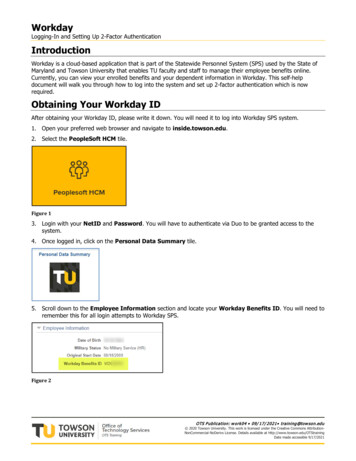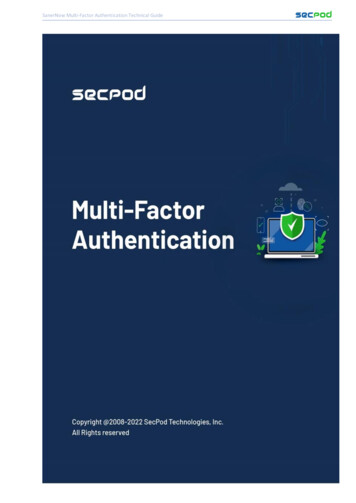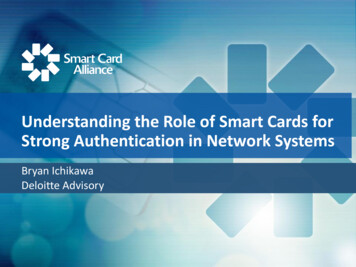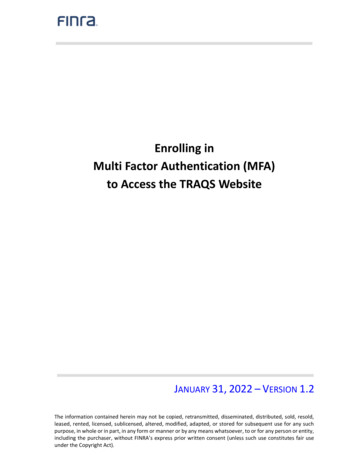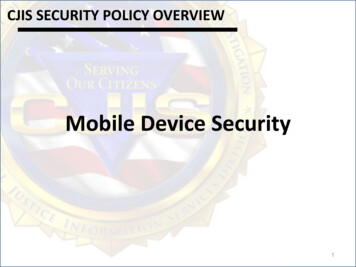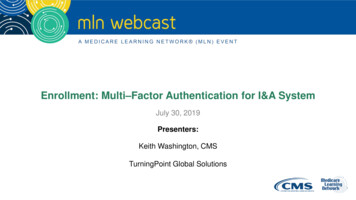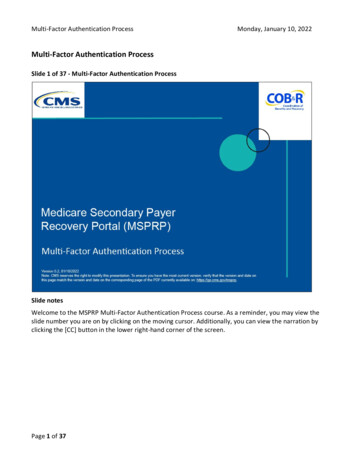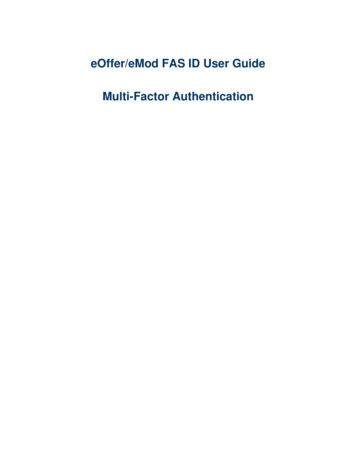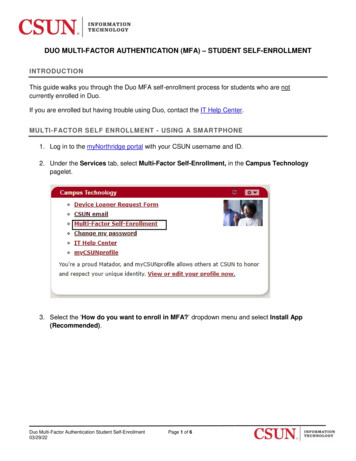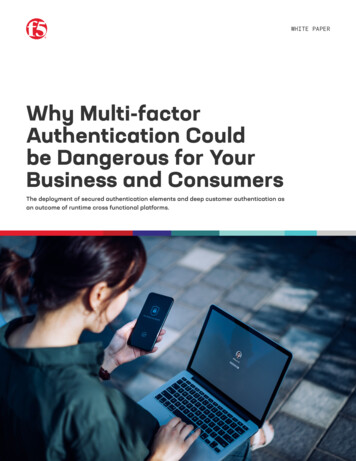
Transcription
WHITE PAPERWhy Multi-factorAuthentication Couldbe Dangerous for YourBusiness and ConsumersThe deployment of secured authentication elements and deep customer authentication asan outcome of runtime cross functional platforms.
Conditions within which businesses must succeed have never been morechallenging. The need to embrace explosive digital transformation is mademore complicated by navigating vast solution portfolios offered by vendors.This is further compounded by regulatory and compliance requirementsthat seek to secure consumers who are moving to and spending more timeonline than before.In a business environment where customer behavior is changing, digital transformationis accelerating, the threat of fraud is proliferating and challengers are gaining ground,organizations must change their approach to succeed. A fundamental priority is to findcapabilities that offer the opportunity to both reduce bottom-line cost and, by doing so,increase top-line revenue while ensuring compliance. In other words, companies shouldinspect their portfolios and divest in capabilities that provide only cost-out or revenue-inoutcomes in favor of those that do both and at the same time ensure regulations are met.To find these capabilities, C-suite members must be bold enough to ask internal processesowners to think beyond their domains and relentlessly look to solve through cross-functionalcost-out and revenue-in capabilities that offer secure ways to transact with their customers.In an extension to the whitepaper “The New Business Imperative” by Paratha Sarathy andLarry Venter where the authors contended that to be effective in the rapidly transformingdigital business world, companies will need to embrace cross-functional capabilities thatcurb costs and grow revenue, authors Chris Fuller and Larry Venter now shine a light on howruntime cross functional capabilities not only extend business value but also offer uniqueand exciting ways to creatively solve for regulatory and compliance challenges such asStrong Customer Authentication. They challenge the conventional approach of Multi FactorAuthentication as the dominant way to legitimize users suggesting rather that platformsenabling runtime cross functional capabilities offer faster, frictionless and more profitablesolutions while considerably improving adherence to regulatory compliance.SHAPE, AS A CROSS-In the following paragraphs, the authors will set out to nullify the reliance on conventionalFUNCTIONAL COST-OUTMFA as a secure and compliant mechanism for user authentication required by PSD2. TheyAND REVENUE-IN PLATFORMwill surface the concept of Secured Authentication Elements as an outcome of runtime crossEQUIPS CUSTOMERS WITHfunctional platforms as alternative or complimentary SCA compliant authentication methodsTHE ABILITY TO REDUCEthat are more secure and allow you to offer improved customer experience while respectingPRESSURE ON THE BOTTOMLINE AND SIMULTANEOUSLYGROW TOP-LINE REVENUE.regulatory necessities. Finally, they will set out the dangers of the prevalent Multi FactorAuthentication methods being used today and introduce the reader to the concepts of SimpleCustomer Authentication and Deep Customer Authentication.Shape, as a cross-functional cost-out and revenue-in platform equips customers with theability to reduce pressure on the bottom-line and simultaneously grow top-line revenue.Evolving beyond the synthetic traffic detection and mitigation capability, Shape hasdeveloped the ability to reduce human related fraud activity in an unrivaled way, ensuringWhy Multi-factor Authentication Could be Dangerous for Your Businessand Consumers2
that only legitimized users enter your systems and benefit from your investments. Shape’scross functional platform offers a unique opportunity to rethink investments across security,fraud and identity capabilities while providing unparalleled outcomes across said functions.Payments Services Directive 2 and StrongCustomer AuthenticationIt is expected that by 2023 digital marketing spend will be 60.5% of total media spendingat 517.51B worldwide. The main goal of digital ad spend is to drive traffic to their web andmobile channels to provide a personalized consumer experience leading to sales conversionand increased revenue. Organizations are also working to derive maximum benefit fromconsumer data, leveraging machine learning and artificial intelligence to provide the nextbest offer and provide a one-click checkout and authentication experiences. In every industrythere is a surge in pressure to increase revenue and reduce operating costs and losses.Digital transformation has become imperative. Signaling renewed urgency to increaserevenue across the board, IDC estimates organizations will spend 7.4 trillion dollars ondigital transformation efforts between 2020 to 2023.The increased investment and focus on digital transformation have provided a larger attacksurface for fraudsters. To combat this, organizations like the European Banking Authority(EBA) have worked diligently to ensure consumer protection through issuances of decreeslike the Payments Services Directive 2 (PSD2) which attempts to protect users throughStrong Customer Authentication (SCA). Specifically, article 4, Paragraph 30 “strong customerauthentication” means an authentication based on the use of two or more elementscategorized as knowledge (something only the user knows), possession (something onlythe user possesses) and inherence (something the user is) that are independent, in that thebreach of one does not compromise the reliability of the others and is designed in such a wayas to protect the confidentiality of the authentication data.Deconstructing Strong CustomerAuthenticationBefore offering a creative, advanced and more secure way of complyingwith SCA it is perhaps incumbent upon us to look more closely at PSD2Article 4, Paragraph 30 which outlines the requirements for StrongCustomer Authentication.A cursory consideration of the above would have security and fraud practitioners as wellas proponents of frictionless user experiences pondering several questions. Most of thesequestions introduce a security/fraud vs customer experience conundrum to businessesWhy Multi-factor Authentication Could be Dangerous for Your Businessand Consumers3
and users alike. While security and fraud agents may wonder why for instance most onlineproperties appear to only use two elements to meet regulatory compliance (the literalminimum bar), user experience agents lament the friction introduced by meeting (the literalminimum bar) PSD2 regulatory compliance.How Does PSD2 Define "Knowledge"Complaint elements for knowledge are defined as “something only the user knows”and include (but are not limited to): Passwords PIN's Knowledge based response to challenges or questions Passphrases Memorized swiping pathsShape security has the ability to gather “knowledge elements” and use them as part of theauthentication process in conjunction with other Secured Authentication Elements to validateusers should the customer require that as part of their solution.How Does PSD2 Define "Possession"Compliant elements for possession are defined as “something only the user possesses”and include (but are not limited to): Possession of a device evidenced by an OTP generated by, or received on, a device(hardware or software token generator, SMS, OTP) Possession of a device evidenced by a signature generated by a device (hardware orsoftware token) App or browser with possession evidenced by device binding such as (private keylinking an app to a device, or registration of the web browser linking a browser toa device) Note: approaches relying on mobile apps, web browsers or the exchange of (public andprivate) keys may also be evidence of possession, provided that they include a devicebinding process that ensures a unique connection between the PSU's app, browser orkey and the deviceWhy Multi-factor Authentication Could be Dangerous for Your Businessand Consumers4
Shape security has the ability to generate a Device ID that when linked to a Unique UserID creates a link between Device and User. Our Secured Authentication Elements furtherenhance the bonding between device ID and UUID with other user generated elements andbehavioral characteristics that can be used to validate the user.How Does PSD2 Define "Inherence"Compliant elements for inherence are defined as “something only the user is”. Theseelements are related to biological and behavioral biometrics, physical properties of bodyparts physiological characteristics and behavioral processes created by the body and anycombination of these and is the most fast moving and innovative element. Complianceelements for inherence include (but are not limited to): Retina and Iris Scanning Fingerprint scanning Vein recognition Face and hand geometry Voice recognition Keystroke dynamics (identifying the user by the way they type and swipe, sometimesreferred to as typing and swiping patterns) Heart rateShape security uses rich and varied sets of Keystroke Dynamics to inspect behavioralcharacteristics which when combined with other Secured Authentication Elements such asDevice ID can confidently authenticate and score the intent of the user.The Multi-factor Authentication MythWhat is clear from PSD2 is that the EBA requires Strong Customer Authentication. The EBAalso outlines what needs to be done to achieve compliance - authentication based on theuse of two or more elements categorized as knowledge, possession and inherence. Nowheredoes it suggest that Multi Factor Authentication (MFA) is a requirement. It is likely that MFAand or 2FA has become an umbrella term used by businesses to describe the process ofauthenticating a user. What is also evident is that compliance through MFA /2FA has becomessynonymous with two of the most prevalent authentication methods used by businesses,namely One Time Passwords (OTP) and Short Message Service (SMS).There has been debate about the security of SMS as a delivery mechanism for OTP. The EBArulebook provides some further context:Why Multi-factor Authentication Could be Dangerous for Your Businessand Consumers5
“In this context, a one-time password sent via SMS would constitute a possession elementand should therefore comply with the requirements under Article 7 of the DelegatedRegulation, provided that its use is ‘subject to measures designed to prevent replication ofthe elements’, as required under Article 7(2) of this Delegated Regulation. The possessionelement would not be the SMS itself, but rather, typically, the SIM-card associated with therespective mobile number.PAYMENT SERVICEIn addition, regardless of whether a strong customer authentication element is possession,PROVIDERS SHALL ENSUREknowledge or inherence, Article 22(1) of the Delegated Regulation requires that “paymentTHE CONFIDENTIALITYservice providers shall ensure the confidentiality and integrity of the personalized securityAND INTEGRITY OF THEcredentials of the payment service user, including authentication codes, during all phases ofPERSONALIZED SECURITYthe authentication” and Article 22(4) of the Delegated Regulation states that “payment serviceCREDENTIALS providers shall ensure that the processing and routing of personalized security credentialsand of the authentication codes generated in accordance with Chapter II take place in secureenvironments in accordance with strong and widely recognized industry standards”.The challenge here surrounds the statement that “payment service providers shall ensurethe confidentiality and integrity of the personalized security credentials ” Given that SMSmessages are delivered in clear text, there are inherent known vulnerabilities in the SS7protocol used to deliver SMS messages, and examples of mobile malware that are designedto steal text messages from user devices, it seems illogical to require PSPs to ensure integritywhile still allowing SMS as an OTP delivery option.Beyond SMS, we have seen how fraudsters and cybercriminals have changed tactics,targeting the week human link in the authentication chain. Cybercriminals can procurephishing kits and services online (see the recent takedown of the “SMS Bandits” as anexample) in order to create convincing mechanisms that persuade end users to divulgetheir information and rapidly share that data with waiting operatives. Meanwhile,sophisticated phishing kits such as Kr3pto give experienced threat actors the ability tointercept OTPs in real time.From the above it should be evident that businesses relying on any of the aboveauthentication methods are effectively introducing a security risk and exposing theircustomers to harmful practices in an attempt to meet SCA regulatory requirements.In contrast, Shape, as the only true runtime cross functional platform, enables StrongCustomer Authentication by offering unrivaled authentication services across all threecompliant elements required by SCA.Why Multi-factor Authentication Could be Dangerous for Your Businessand Consumers6
What Does SCA Compliance Typically LookLike Today?Each reader of this paper has been challenged through either OTP or 2FA as a method ofauthentication. Where only two elements compliant elements are used to authenticate auser we refer to it as Simple Customer Authentication – meeting the literal lowest bar forcompliance.Below is a schematic of Simple Customer Authentication typically experienced in moneytransfers for example. Step 1: User approaches online property or application. Step 2: Username is either entered or prepopulated (username is not a knowledgeelement on its own). Step 3: User enters Password or PIN (a compliant knowledge element). Step 4: User attempts to transfer money and is stepped-up through the provisioningof a One Time Password or SMS (both compliant possession elements). Step 5: User enters OTP/SMS and can complete transfer.In the above authentication flow the bare minimum is done to achieve compliance underPSD2. Two compliant elements are indeed used to authenticate but when considered withan understanding that OTP/SMS is a porous authentication method, businesses deployingthis authentication method and users experiencing it should not rest easy. This low-levelauthentication is an example of Simple Customer Authentication.KNOWLEDGE ELEMENTPOSSESSION ELEMENTPasswordOTP/SMSVerify Step 1Verify Step 2Figure 1: Light ComplianceUsenameLoginMFASCA CompliantWhy Multi-factor Authentication Could be Dangerous for Your Businessand Consumers7
What Does Deep SCA Compliance Look Like?By contrast, Deep Customer Authentication as an outcome of runtime cross-functionalplatforms offers a fresh, more secure and faster method of authentication using threecompliant elements. The deployment of Shape’s Secured Authentication Elements rendersthe need for any step-up mechanism unnecessary while remaining compliant with PSD2and Strong Customer Authentication requirements. With Deep Customer Authenticationthe customer can choose to authenticate using a “possession element” and an “inherenceelement” and can even offer a third “knowledge element” to authenticate against.As acknowledged by the European Banking Authority, the “inherence element” is the mostexciting and progressive arena for authentication. In the scenario below two authenticationmethods are explored as alternatives to the Simple Customer Authentication example formoney transfer above:Method 1—Deep Customer Authentication (3 element verification) Step 1: User approaches online property or application. Step 2: Username is either entered or prepopulated (note that username is not aknowledge element on its own) Step 3: User enters Password or PIN (a compliant knowledge element) Step 4: Platform performs runtime “possession element” verification through Device ID Step 4: Platform performs runtime “inherence element” verification throughKeystroke Analysis Step 5: User is verified and completes money transfer with no step-up friction.Method 2—Deep Customer Authentication (2 element verification) Step 1: User approaches online property or application. Step 2: Platform performs runtime “possession element” verification through Device ID Step 3: Platform performs runtime “inherence element” verification throughKeystroke Analysis Step 4: User is verified and completes money transfer with no step-up friction.Both flows above are examples of Shape’s Secured Authentication Elements beingdeployed to authenticate a user in compliance with PSD2’s Strong Customer Authenticationrequirements. As and outcome of a runtime cross functional platform Secured AuthenticationElements achieve compliance faster, offer a more secure authentication method and removefriction from the user.Why Multi-factor Authentication Could be Dangerous for Your Businessand Consumers8
KNOWLEDGE ELEMENTSPOSSESSION ELEMENTSINHERENCE ELEMENTSUsenamePasswordDevice IDBrowser LinkKeystrokeDynamicLoginVerify Step 1Verify Step 2Verify Step 3Figure 2: Deep SCA ComplianceMFASCA CompliantSCA CompliantIn SummaryFrom the above it should be evident that Multi Factor Authentication, as applied broadlytoday, should be seen as having met the lowest possible bar for Strong CustomerAuthentication as required by PSD2. Further, as the lowest possible bar of authentication MFAcould literally be putting your organization and your customers security in jeopardy. It shouldalso be clear Strong Customer Authentication, not MFA, is the PSD2 regulatory requirement.Instead, Deep Customer Authentication achieved within the Shape platform offers rigorouscross functional analysis in Security, Fraud and Identity functions. The use of SecuredAuthentication Elements allows higher fidelity and more flexible authentication methodsthat align with the SCA compliant requirements of knowledge, possession and inherence.To learn more, contact your Shape Security or F5 representative, or visitshapesecurity.com or f5.com. 2021 F5, Inc. All rights reserved. F5, and the F5 logo are trademarks of F5, Inc. in the U.S. and in certain other countries. Other F5 trademarks are identified at f5.com.Any other products, services, or company names referenced herein may be trademarks of their respective owners with no endorsement or affiliation, expressed or implied, claimed by F5, Inc.DC0420 JOB-CODE-660017314
The Multi-factor Authentication Myth What is clear from PSD2 is that the EBA requires Strong Customer Authentication. The EBA also outlines what needs to be done to achieve compliance - authentication based on the use of two or more elements categorized as knowledge, possession and inherence. Nowhere


